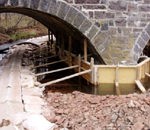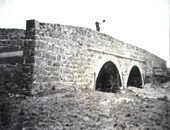![]()
Anyone familiar with the Pennsylvania landscape has grown quite fond of its quaint countryside passages and would place a high value on preserving its charming appeal. Pennsylvania’s landmark bridges are the epitome of efforts aimed at historic protection, claiming devotees from private and public sectors alike. As the Nation’s leading host of authentic covered bridges, The Greater Philadelphia Region alone has North America’s largest population of stone arch highway bridges. Pre-dating motorized vehicles, traffic, and the need to accommodate two-way travel, these single-lane icons are becoming increasingly difficult to protect, and any success in doing so is quickly touted as a victory. Rehabilitation of the double-barrel stone masonry arch crossing Macoby Creek along Eleventh Street in Upper Hanover Township, PA, undertaken by the Montgomery County Department of Roads and Bridges, presents such a victory.
 Originally constructed in 1906, the aging bridge was experiencing an ever-worsening condition as deterioration of the concrete arch culverts and footers was progressing in a downward spiral fashion. Large cracks and spalling along the underside of each barrel was compounded by scoured footers and an eroded foundation. Already operating with a reduced load rating of ten tons, the bridge was being slated for decommissioning until load capacity could be increased to current standards. The daunting question was whether to replace the structure, possibly including an upgrade to AASHTO standards for a two-lane bridge, or rehabilitate the long-standing beauty.
Originally constructed in 1906, the aging bridge was experiencing an ever-worsening condition as deterioration of the concrete arch culverts and footers was progressing in a downward spiral fashion. Large cracks and spalling along the underside of each barrel was compounded by scoured footers and an eroded foundation. Already operating with a reduced load rating of ten tons, the bridge was being slated for decommissioning until load capacity could be increased to current standards. The daunting question was whether to replace the structure, possibly including an upgrade to AASHTO standards for a two-lane bridge, or rehabilitate the long-standing beauty.
The decision was made to preserve the structure to the extent possible by implementing a number of improvements to increase structural capacity and enhance right-of-way safety. The chief component needed to address structural deficiencies was corrugated steel structural plate, an engineering material long 
recognized as a standalone product but becoming used more and more as a relining material in rehabilitating aging infrastructure. To accommodate the relining the design engineer specified two 22-ft long, 19′-0″ x 5′-9½” structural plate arches.
To view the full case study click here